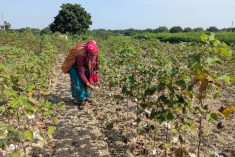Aug. 31 CNS Canada – The Saskatchewan harvest is moving forward well ahead of the five-year average with 26 percent now in the bin, compared to 16 percent from 2012-16, according to Saskatchewan Agriculture’s latest crop report.
As well, about 24 percent of the crop has been swathed or is ready to straight cut.
The southwest leads all regions in harvest progress with 49 percent combined. In the southeast, 37 percent has been combined, 23 percent in the west-central, 14 percent in the east-central and five percent has been harvested in northern grain growing areas.
Read Also

Mixed year for hail claims across Prairies: CCHA
The 2025 crop year was an average year for hail across the Canadian Prairies, with overall claim numbers down slightly compared to last year, reported the Canadian Crop Hail Association (CCHA).
Province-wide, 98 percent of winter wheat is in the bin, fall rye 98 percent, lentils 76, peas 74, mustard 42, durum 32, barley 26, spring wheat 14, canola 10, soybeans 8, chickpeas 7, oats 7, canaryseed 2 and flax 1.
Provincial yield estimates released with the crop report Aug. 31 show hard red spring wheat yields of 38 bushels per acre, but only 27 bu./acre in the dry southwest and 39 bu./acre in the southeast.
Winter wheat was coming in at 44 bu./acre across the province, but only 24 in the southwest.
Durum yields are reported at 29 bu./acre in the heavy durum-growing area of the southwest, and at 30 bu./acre for the overall provincial average estimate.
The provincial estimate for canola was 31 bu./acre, barley was estimated at 57 bu./acre, peas at 32 bu./acre, lentils 1,293 pounds per acre, mustard 753 lb./acre, canaryseed 959 lb./acre and flax at 19 bu./acre.
Little rain fell across the province last week, with Rama recording the highest level at 10 millimetres.
Topsoil moisture continues to deteriorate, with cropland rated one percent surplus, 26 percent adequate, 44 percent short and 29 percent very short.
Hayland and pasture soil moisture is rated at one percent surplus, 20 percent adequate, 37 percent short and 42 percent very short.
Strong winds and insects were reported as causing damage in some regions as farmers continue to scout for problem bugs, such as bertha armyworms in canola.














